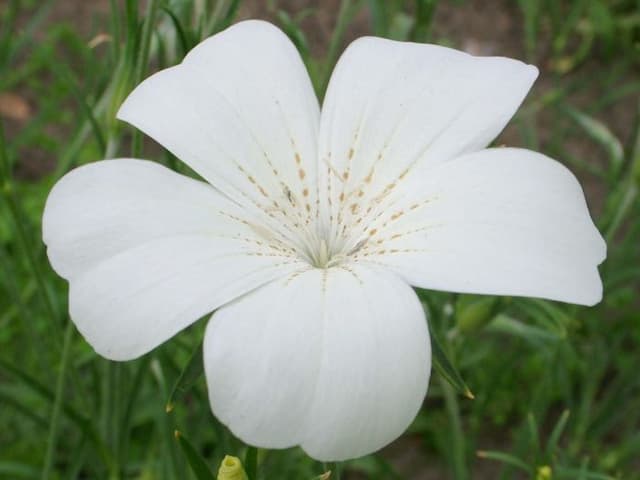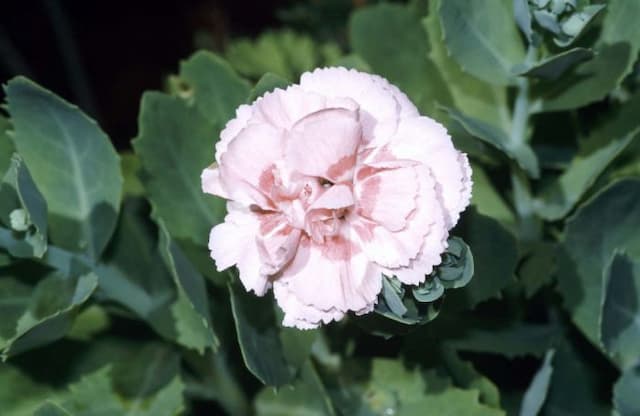Pink Dianthus 'Devon Yolande' (PBR) (Scent First Series) (p)

ABOUT
Dianthus 'Devon Yolande', which is part of the Scent First Series, is known for its striking and fragrant blooms. This perenniual plant boasts a lush mound of narrow, green leaves that provide a complementary backdrop to the flowers it produces. The blossoms are a standout feature with their frilly edges, exuding a romantic charm. Each flower combines a palette of soft pinks to deeper magenta hues, often having a distinctive pattern or a darker eye in the center that draws attention. The petals are arranged in a dense cluster at the tip of the stems, almost giving the impression of a miniature bouquet. Together with their ruffled appearance and deeply saturated colors, the flowers emit a powerful, spicy clove-like fragrance that is particularly strong during the morning and evening hours, making it a favorite with gardeners who enjoy scented varieties. Blooming typically occurs in the late spring and may continue into early summer, with potential for a secondary flush of flowers if the conditions are favorable and the spent blooms are removed. This variety of Dianthus is appreciated not only for its beauty and scent but also for its durability in the garden setting, being able to withstand various conditions once established. Its tightly clumping growth habit and evergreen foliage ensure that it brings year-round interest even when not in bloom.
About this plant
 Names
NamesFamily
Caryophyllaceae
Synonyms
Devon Yolande Pink, Scent First Pink
Common names
Dianthus 'Devon Yolande'.
 Toxicity
ToxicityTo humans
The Dianthus 'Devon Yolande', commonly known as Pink, is not considered toxic to humans. There is no significant risk of poisoning or adverse health effects from touching or ingesting the plant for most individuals. However, it is always advisable to exercise caution and not consume parts of ornamental plants as a general safety rule.
To pets
Pinks are generally considered non-toxic to pets. Therefore, it's unlikely for cats, dogs, or other animals to experience poisoning from ingesting Dianthus 'Devon Yolande'. However, individual animals may have varying sensitivities, and consuming non-food plants could potentially cause mild gastrointestinal upset or irritation. Owners should monitor their pets to prevent ingestion of any plant material, mainly to avoid any possible digestive distress.
 Characteristics
CharacteristicsLife cycle
Perennials
Foliage type
Evergreen
Color of leaves
Blue-green
Flower color
Pink
Height
1 foot 8 inches (50 cm)
Spread
1 foot (30 cm)
Plant type
Herb
Hardiness zones
5
Native area
Europe
Benefits
 General Benefits
General Benefits- Decorative blooms: The Dianthus 'Devon Yolande' features beautiful pink flowers that add color and a decorative touch to gardens and landscapes.
- Pleasant fragrance: Known for its sweet scent, the plant can enhance the sensory appeal of any garden space with its fragrant flowers.
- Long flowering period: This variety often has an extended blooming season, providing a long-lasting display of flowers.
- Attracts pollinators: The blooms can attract beneficial insects such as bees and butterflies, promoting biodiversity in the garden.
- Low maintenance: Typically easy to care for, it requires minimal upkeep once established, making it suitable for both novice and experienced gardeners.
- Drought tolerance: Once established, the plant can be quite drought-resistant, making it suitable for gardens in drier climates or for water-wise landscaping.
- Cold hardy: It is able to withstand frost and cooler temperatures, making it a good choice for gardens in colder regions.
- Versatile use: This plant can be used in various garden settings, including borders, rock gardens, and containers, offering flexibility in landscape design.
 Medical Properties
Medical PropertiesThis plant is not used for medical purposes.
 Air-purifying Qualities
Air-purifying QualitiesThis plant is not specifically known for air purifying qualities.
 Other Uses
Other UsesCulinary Garnish: The petals of Dianthus, commonly known as pinks, are edible and can add a splash of color and subtle spice to salads or desserts.
Textile Dye: The flowers of the pinks can be used to create a natural dye for fabrics, adding a unique tinge to textiles.
Decoration in Ice Cubes: Freeze petals of the Dianthus in ice cubes to create a decorative touch for drinks at parties or gatherings.
Artistic Inspiration: The vibrant colors of Dianthus flowers can be captured by artists in paintings, drawings, and textile designs.
Bookmark Embellishment: Petals or whole flowers can be pressed and used to decorate handmade paper bookmarks.
Bath Salts and Bombs: Petals can be mixed into homemade bath salts or bath bombs for fragrance and beauty.
Homemade Potpourri: The scented flowers of the Dianthus can be dried and added to potpourri mixtures to freshen up the home.
Crafts and Scrapbooking: Pressed Dianthus flowers can be used for adding natural elements to crafts and scrapbooking projects.
Floral "Confetti": Dried or fresh petals can be used instead of traditional paper confetti at celebrations, providing an eco-friendly alternative.
Candle Decoration: Embedding Dianthus flowers into the wax of homemade candles to create visually appealing and subtly fragrant home decor items.
Interesting Facts
 Feng Shui
Feng ShuiThe plant Dianthus is not used in Feng Shui practice.
 Zodiac Sign Compitability
Zodiac Sign CompitabilityThe plant Dianthus is not used in astrology practice.
 Plant Symbolism
Plant Symbolism- Love: Dianthus flowers are often associated with love due to their vibrant colors and sweet fragrance, symbolizing a passionate or affectionate feeling.
- Fidelity: The enduring nature of the Dianthus bloom can represent faithfulness and commitment in relationships.
- Admiration: Giving someone Dianthus flowers can express admiration for their character or accomplishments.
- Boldness: The bright hues and striking appearance of the Dianthus can symbolize daring or boldness in a person's actions.
- Divine Favor: In historical contexts, Dianthus flowers were believed to be favored by the gods, signifying approval or blessing.
 Water
WaterThe Pink, or Dianthus 'Devon Yolande', prefers to be watered once or twice a week, depending on weather conditions. During hotter and dryer periods, increase the frequency to keep the soil slightly moist but never waterlogged. Apply water directly to the base of the plant using a watering can or hose attachment, avoiding wetting the foliage to prevent disease. Generally, aim for about one inch of water per week, which is approximately 0.62 gallons, ensuring even soil moisture.
 Light
LightPinks thrive in full sunlight, which means at least six hours of direct sun daily. The best spot for this Dianthus variety is in a south-facing position where it can receive unfiltered sunlight for most of the day. Avoid too much shade as it may impede flowering and lead to leggy growth.
 Temperature
TemperaturePinks prefer a temperate climate with temperatures ranging from 40°F to 85°F; however, they can tolerate temperatures as low as 20°F and as high as 90°F for short periods. The ideal growing temperature is between 60°F and 75°F, ensuring the plant's vitality and flower production.
 Pruning
PruningPinks should be pruned to encourage bushy growth and to remove dead or spent flowers, which can stimulate new blooms. Light pruning can be done throughout the flowering season, with more extensive cutting back performed in early spring or autumn. The best time to prune is after the first flush of bloom has ended, to rejuvenate the plant for further flowering.
 Cleaning
CleaningAs needed
 Soil
SoilThe best soil mix for Pink is one that is well-draining with a neutral to slightly alkaline pH of 6.7 to 7.5. A mix of loam, compost, and coarse sand or perlite is ideal, ensuring adequate drainage and fertility.
 Repotting
RepottingPinks typically do not require frequent repotting and can thrive in the same pot for several years. They should be repotted only when they have outgrown their current container or the soil has become exhausted.
 Humidity & Misting
Humidity & MistingPinks prefer moderate humidity levels but are quite adaptable and can tolerate drier conditions. They do not require high humidity levels to thrive.
 Suitable locations
Suitable locationsIndoor
Place Pinks near a sunny window and ensure good air circulation.
Outdoor
Plant Pinks in well-draining soil in a sunny spot.
Hardiness zone
5-9 USDA
 Life cycle
Life cycleDianthus 'Devon Yolande', commonly known as Pink, typically begins its life cycle as a seed. When planted, it germinates and emerges as a seedling, growing true to its parent plant due to its propagation through breeding rights protected under Plant Breeder's Rights (PBR). As a perennial, it develops a root system and foliage during its growth stage, followed by the development of its distinctive, fragrant flowers in late spring to early summer. After blooming, it may undergo a period of dormancy, particularly in colder climates during winter. If conditions are favorable, Pinks can re-emerge from dormancy in the spring, and the cycle of growth and flowering can repeat for several years. During its maturity, the plant may be divided or cuttings may be taken for propagation, ensuring a continuation of its lineage.
 Propogation
PropogationPropogation time
Spring to Summer
Dianthus 'Devon Yolande', also known as Sweet William, is effectively propagated by cuttings. This method involves taking a healthy piece from the mother plant, which should be 4-6 inches (10-15 cm) long. The best time to take cuttings for Sweet William is during late spring or early summer. To ensure a good result, choose non-flowering shoots, as these will root more effectively. Cut just below a node, strip the lower leaves, and dip the cut end into rooting hormone powder to encourage root development. Then, plant the cutting into a pot filled with a mixture of peat and perlite. Keep the soil consistently moist but not waterlogged and covered with a plastic bag to maintain high humidity. Place the pot in a warm, bright area out of direct sunlight until the cutting has rooted, which usually takes a few weeks. Once rooted, the new Sweet William plants can be transplanted into the garden or pots.








![Pink [Bubblegum]](/_next/image?url=https%3A%2F%2Fplants-admin.emdemapps.com%2Fimages%2Fplants%2F%2Fimages%2F604b596f31cbb.png&w=640&q=75)
